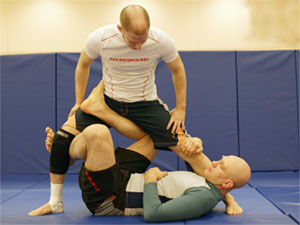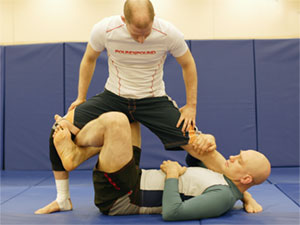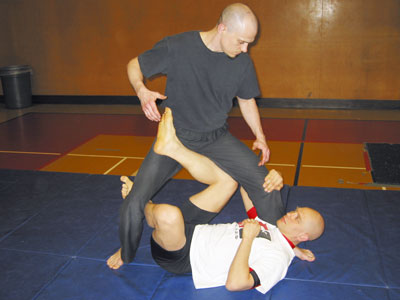The questions in this article arose, in part, from a discussion of my Butterfly Guard and X Guard video, which is part of the Guard Sweeps DVD Package. Of course everyone is welcome to read on, but for maximum benefit it’d probably be a good idea to pick up a copy of this 2 DVD package
Stephan Kesting
Why would you ever use your feet in the ‘wrong’ X Guard position as opposed to the ‘right’ X Guard Position

The ‘Right’ Way |

The ‘Wrong’ Way |
Crossing the feet ‘the wrong way’ is one of four X Guard variations that Elliott Bayev and I talk about in Half Guard Glossary article (down near the bottom of the page).
Normally I like the ‘normal’ X Guard (with one foot in the hip, the other behind the knee), but I sometimes use the ‘wrong way’ X Guard for one of three reasons
- If my feet got all tangled up, and I ended up in the wrong position. In this case I may make the snap judgement to try and sweep from here rather than taking the time to readjust the position. It all depends on what you’re feeling from your opponent.
- If I started in the ‘normal’ X Guard but he pushed my top foot down, off of his hip. Better that it’s hooking something rather than hooking nothing. (and it leads into what I call the ‘Banana Peel Sweep’ which *ahem* I teach in my Butterfly Guard and X Guard DVD)
- If he’s a heel hook fanatic and very skilled at hitting leglocks from different positions, then my legs are slightly safer in the ‘wrong way’ X Guard. I may be willing to trade lesser amounts of control for having greater safety
When is it a good idea to sweep your opponent directly sideways and when is it better to sweep 45 degrees sideways and front? (This question is referring to the article Stephan wrote on the 2 variations of the ‘basic’ butterfly sweep)
There isn’t really a cut and dried answer to this – which sweep you use depends on a variety of factors:
- Which variation you are most comfortable with
- His posture and energy (is he leaning forward, sideways, backwards, etc.)
- Whether (and how) he is trying to control your feet with his hands.
- What his reaction is if you move your foot under your leg (sideways sweep setup) and what his reaction is when you shift your hips to 45 degrees (45 degree variation)
- Whether you want to go to the mount or to sidemount
- etc.
It is important to practice both variations of the butterfly sweep, because that will teach you how to apply a similar technique at two different angles. When it actually comes to applying the technique in sparring you often mix and match elements of the two different variations, and you can’t actually say with any certainty if it was variation 1 or variation 2.
This is a little bit like a boxer practicing both hooks and uppercuts, but then in sparring they end up knocking an opponent out with a ‘hookercut’, i.e. a punch that is a mishmash of the two separate punches.
I’m wondering about the pros and cons of the following butterfly guard bottom strategies:
- always attempting to go for the double underhook position,
- always try to get the over/under arm position and scoot your hips out.
The main advantage of the double underhook is that it is difficult for him to pass your guard and that it is relatively easy to hoist him up in the air above you (from which you have quite a few options to sweep and/or submit him).
The main advantage of the over-under position is that whenever you are in that position you are threatening him with the basic butterfly sweep. His resistance/reaction to that threat then drives many of your secondary attacks.
What, in your opinion, should be the first 3 moves from the butterfly guard (bottom) to focus on?
I’ll give you three moves, but divide one move into two variations:
- the 45 degree butterfly sweep AND the sideways butterfly sweep (see 2 variations of the ‘basic’ butterfly sweep)
- the basic ‘rock up’ motion (i.e. get the double underhooks or the bear hug and then fall straight back, lifting him up over you and attempting to sweep him over your head. This rarely works as advertised BUT is a great setup for lots of other attacks)
- the ‘situp sweep’ (i.e. where you drive him straight back, with or without an ankle pick).
What do you generally do when the opponent is so sprawled out, my hooks are barely reaching. Generally, he’s sprawled out and moving slowing around in a really tight, low pass.
The situation you describe is a difficult position to play butterfly guard in! That is one reason why the underhook in the butterfly guard is so damn useful – it keeps his weight on top of you where you can sweep him.
If I were caught in this position, though, I would see if I could get my legs free, snap his head down to the ground and come on top with a guillotine or front headlock. If I couldn’t get my legs out from under him I might switch to half guard or spider guard.
For those who rely on butterfly guard, what other open guards do they use? Ever since I started using this guard, I pretty much only use butterfly and x-guard. Is this normal? Or will I still need spider guard, de la riva, etc.
It is normal (and desirable) to concentrate semi-exclusively on a new game while you are developing it. This is no different than deciding to work on your arm-bars, and then try to submit your sparring partners using nothing but arm-bars.
That being said, the butterfly guard does dovetail very nicely with some other types of guard work. For myself I find that it complements the half guard, and I find myself transitioning from half guard to butterfly guard, and back, all the time.
I am currently a blue belt: is it too soon for me to start working on the X-guard or butterfly guard?
The traditional answer would have been that you should work on techniques that start in the closed guard (e.g. the armbar, kimura, triangle, scissor sweep, breaking his posture, etc.) for several years, and only then progress to open guardwork. I agree with this to a certain extent – you should probably know how to do an armbar from the closed guard before you start working on advanced open guard material, but you should also familiarize yourself with the open guard because your guard WILL get opened for you by your opponents!
The reality is that there are lots of blue belts with very effective butterfly and X guard games. There are some schools that start teaching the butterfly guard in a student’s first week on the mat, and it doesn’t seem to hurt them in competitions. Although I have no proof of this, my guess is that competitors who are really good at the butterfly guard and X guard probably started developing them quite early in their BJJ careers.
So my advice would be to go ahead and have fun using the butterfly guard and X guard.
I was wondering if it is possible to get the X guard from the 1/2 guard instead of the butterfly guard.
The quick answer is that it IS possible to get from the half guard directly to the X guard, but it is a little harder than from the butterfly guard.
It is harder because of at least 2 factors:
- his weight is usually lower down when in your half guard, so you have to hoist him up further to achieve X guard
- in half guard the top player is usually more ‘anchored’ to you than in butterfly guard. This makes him heavier and more difficult to hoist up.
Most of the time it is easiest to go from half guard to butterfly guard, and then from butterfly guard to X guard. From butterfly guard, of course, you also have the option of returning to the half guard.
That being said, you CAN go directly from half guard to X guard, but this usually occurs when he stands up and/or is basing out to avoid being swept by a half guard sweep.
I’m trying to use the butterfly and my opponent keeps ‘posture’, and prevents me from from sitting up by pushing my face with either his hands or his forearms. The ‘face-push vs. butterfly guard’ is a problem I encounter mostly with one rather rough fellow who is about as fast, strong and smart as a gorilla. Any attempts to sit up from butterfly to a bear-hug, overhook or underhook is met with a stiff palm or forearm strike to the face/nose area. I normally end up using my half-guard, so I don’t have to sit up, but this usually ends in simply a stalemate.
Your opponent is probably a little smarter than a gorilla because he is doing a very sensible thing – he is keeping you from sitting up and obtaining a good position from which to sweep him. Here are some suggestions on how to deal with this problem:
- Armdrag, armdrag, armdrag! If you were in wrestling class and complained to your coach that someone kept on shoving you, the coach would probably tell you to armdrag him as he pushes. The goal of armdragging him is to take get behind him and take his back. If you armdrag him you’ll either be able to get to his back OR get him so worried about pushing you that he’ll keep his arms to himself a little bit more
- Another option is to stand up (or come to your knees) pummel for grip there, and then jump back to butterfly guard with the grip already in place.
What do you do if you’re doing X guard and your opponent tries to toe hold your top foot (the one hooked onto his hip)?

To illustrate this question I am on the bottom, using the X guard. My opponent is thinking about applying a toehold footlock to my right foot (hooked into his hip).
Using the toehold to counter the X guard is a valid technique, so you need to have some solutions to this problem!
To make it more difficult for your opponent to footlock you in this position you must do 2 things:
- Continually off balance your opponent. Once you’ve got the X guard position you need to continually off balance him so that he needs both of his hands to balance and base out. If he isn’t being off balanced then he can use his hands to attack and counter you, so give him the rodeo ride of his life!
- Use your awareness – anytime that his hands come close to that foot (either to push it down or to footlock it) you have to react quickly. Dropping the attacked foot down and going to the ‘banana peel’ sweep (the 5th X guard sweep on Dynamic Guard Sweeps Vol. 1) might be your best option
If I sit on my butt to play the sitting butterfly guard how do I get him close enough so I can get some grips? It is hard to keep him from getting some space, faking me out and running around me so I have to catch him in half guard or full guard. How do I control this situation?
Staying at a distance and then scrambling around a sitting guard is a common strategy in sparring and competition. If you just sit on your butt without a grip then it really comes down to speed: his speed at running around your legs vs your speed at pivoting and repositioning. If you and your opponent are equally fast then, in my opinion, he has a slight advantage.
Some high-level players can get away with just sitting down and waiting for for their opponent to make a move, but those guys are at an elite level and tend to be super fast, so what applies to them may not apply to ordinary mortals like us… A lot of that game involves baiting your opponent to try to pass your guard by grabbing/touching your legs and then going to an armdrag. If you want to play their game then drill the armdrag a lot.
My advice to ordinary mortals is to secure some sort of grip before sitting back. Get an underhook, overhook, bearhug, lapel and knee grip or some other grip before going from your knees to your butterfly guard. You might also want to take a look at an innovative way to jump to guard demonstrated by BJJ great Vitor ‘Shaolin’ Ribeiro
One thing that shaped my thinking on this subject was when I asked Marc Laimon (butterfly guard expert extraordinaire) what he liked to do when his opponent broke away from his grip and stood up. His answer was “stand up yourself, close the distance, get a grip, and jump back to guard”. Apparently he’s not a big fan of sitting on his butt and giving his opponent lots of room to develop momentum to run around him either.
I always find myself in this position: I have the butterfly guard hooks in, he’s flattened me on my back and my legs are all jammed up. Usually he passes soon after. I know the best thing to do is not get in this position, but what do I do once I’m here. I’m not sure how to get out of this.
Some people (but not me) are good at fighting from flat on their backs in the butterfly guard. Generally speaking, however, the sitting butterfly guard is more powerful, versatile and harder to defend against than the lying-flat-on-the-back butterfly guard. When an opponent forces me flat onto my back I initially concentrate on doing two things to slow his guard pass down:
- fight for the underhook, at least on one side
- really try to follow his legs with your instep hooks
I then usually try to do one of the following things:
- sit up by framing his neck and kicking his legs back with my insteps
- OR sit up by pushing his head with my hand and escaping my hips to the side
- OR switch to half guard
Much more information about the the butterfly guard and X guard, including over 80 techniques, principles, counters, followups, and drills, is available by ordering Dynamic Guard Sweeps Vol. 1 available at Grapplearts.com
The post Butterfly Guard / X Guard Q & A appeared first on Grapplearts.
